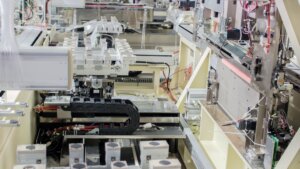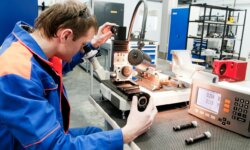Picture this: a sophisticated system where design, manufacturing, and quality control are seamlessly integrated to provide maximum efficiency in production processes. This isn’t a far-off dream, but a current reality known as Computer-Aided Manufacturing (CAM). This comprehensive guide will delve into the exciting world of CAM, unravel its history, demonstrate its workings, benefits, and future trends.
What is Computer-Aided Manufacturing?
Computer-Aided Manufacturing, often abbreviated as CAM, is a technology-driven process that uses computer software and machinery to facilitate and automate manufacturing processes. Employed in various industries, CAM enables the translation of computer-aided design (CAD) into manufacturing instructions for computer numerical control (CNC) machines.
These machines, often referred to as machine tools, can include milling machines, CNC routers, CNC machines, and many others. With the assistance of CAM software, these machine tools execute precise manufacturing processes, transforming raw materials into finished products with minimal waste and human error.
Short History of Computer-Aided Manufacturing
The genesis of computer-aided manufacturing can be traced back to the post-World War II era. It was during this period that the first numerical control (NC) machines emerged, laying the groundwork for what would become CAM. These early machines were operated manually, using punched tape to control their movements.
The advent of computers in the 1960s sparked a significant evolution in manufacturing. Computer numerical control (CNC) emerged as an advancement over NC, bringing computer automation to the manufacturing industry. The introduction of CAD/CAM software in the 1970s further revolutionized the sector, seamlessly bridging the gap between design and manufacturing.
How Does Computer-Aided Manufacturing Work?
In essence, CAM works by taking CAD files or models as input and then generating instructions, known as G-code, that control the CNC machine tools. This transformation from CAD model to CAM instruction is performed using a specialized CAM software. Let’s take a deeper dive into this process:
- It all begins with a CAD model, a computer-generated 3D design of the desired product.
- The CAD model is then imported into CAM software.
- Within the software, the CAM system applies predefined machining strategies to generate toolpaths. These paths guide the movement of CNC machines.
- The CAM software translates these toolpaths into a language that the CNC machine can understand – G-code.
- The G-code is then fed to the CNC machine, which carries out the machining process according to these instructions.
- The manufacturing process culminates with the production of a finished part, accurately matching the original CAD model.
What is Computer-Aided Manufacturing Used For?
Computer-Aided Manufacturing is used in a wide array of industries, including automotive, aerospace, and electronics, among others. These sectors benefit from CAM’s ability to optimize production processes, improve product quality, and increase overall efficiency.
In the automotive industry, for instance, CAM is utilized for manufacturing complex components with intricate designs. Similarly, in the aerospace sector, CAM is applied in creating precise parts that adhere to stringent safety standards. In electronics, manufacturers use CAM to automate the production of circuit boards and other components.
How Do Various Industries Use Computer Aided Manufacturing?
Different industries employ CAM in unique ways to suit their specific needs.
- In the Automotive Industry, CAM is essential in the creation of body parts, engine components, and other intricate parts. Thanks to CAM, manufacturers can reduce lead times, increase accuracy, and produce vehicles with high precision and quality.
- The Aerospace Industry requires parts with intricate geometries and exacting standards. Here, CAM is utilized in creating components like turbine blades and air frame structures. Thanks to the precision offered by CAM, errors are minimized, leading to safer and more reliable aerospace systems.
- CAM finds significant use in the Electronics Industry. The manufacturing of circuit boards, electronic components, and intricate semiconductor devices leverages CAM for accuracy and efficiency. This use of CAM ensures a high level of precision, essential for the miniaturization trend seen in electronic devices.
- The Medical Industry also utilizes CAM for creating complex biomedical devices such as prosthetics and surgical instruments. In an industry where customization and precision are critical, CAM’s capabilities are invaluable.
What are the Benefits of CAM for Manufacturing?
CAM systems offer numerous benefits to the manufacturing industry, making it an indispensable part of modern production processes. These benefits include:
- Improved Efficiency: CAM systems optimize the manufacturing process, reducing lead times and improving production speed. This efficiency translates into cost savings and faster time to market.
- Increased Accuracy and Quality: With CAM, the risk of human error is significantly reduced. The precision of computer-controlled machinery ensures the production of high-quality parts with exact specifications.
- Greater Flexibility: CAM software enables manufacturers to quickly adapt to design changes without needing to manually adjust machine setups. This ability makes it easier to customize product designs, accommodating specific customer requests.
- Reduced Waste: CAM systems ensure minimal waste of raw materials by maximizing material usage and optimizing cutting paths.
- Enhanced Safety: Since the manufacturing process is automated, CAM reduces the risk of accidents and injuries on the shop floor.
What are the Most Popular CAM Softwares and Tools?
There is a plethora of CAM software and tools available in the market, each offering unique features and functionalities. Some of the most popular ones include:
- Mastercam: Known for its wide range of features and robust functionality, Mastercam is a popular choice among manufacturers. It offers excellent 3D designing capabilities and supports a broad variety of machines.
- SolidCAM: Integrated with SolidWorks, SolidCAM provides a seamless CAD to CAM transition. Its iMachining feature optimizes toolpaths, reducing machining time and extending tool life.
- Autodesk PowerMill: PowerMill is renowned for its ability to handle complex machining scenarios. It’s ideal for manufacturers dealing with challenging geometries and hard-to-machine materials.
- GibbsCAM: This CAM system is known for its user-friendly interface and powerful capabilities. GibbsCAM supports a full range of machine tools, from 2-axis milling to multi-task machining.
- Siemens NX CAM: NX CAM is part of Siemens’ comprehensive suite of software solutions. It offers advanced functions like robotic machining and additive manufacturing.
What are the Skills Required for CAM?
Operating CAM software and systems requires a unique set of skills, including:
- Technical proficiency: A fundamental understanding of CAD/CAM software, CNC machine operation, and G-code is essential.
- Knowledge of manufacturing processes: A solid grasp of different manufacturing methods, machining processes, and material properties is vital.
- Analytical skills: CAM operators must be capable of interpreting complex designs, diagnosing problems, and making data-driven decisions.
- Attention to detail: Accuracy is paramount in CAM operations. A keen eye for detail helps ensure precision in the manufacturing process.
Is CAM Hard to Learn?
Like any technical field, mastering CAM requires time and practice. However, with the availability of numerous resources, such as online courses, tutorials, and simulation tools, learning CAM has become more accessible. Prior knowledge of CAD can significantly ease the learning curve.
Are There CAM Certificates?
Yes, there are several professional certification programs for CAM. These certificates, offered by institutions like the National Institute for Metalworking Skills (NIMS
), serve to validate a professional’s skills and knowledge in CAM. They often cover areas such as CAM setup, operations, and programming.
What is the CAD to CAM Process and Why is it so Important for the Manufacturing Industry?
CAD (Computer-Aided Design) to CAM (Computer-Aided Manufacturing) is a seamless transition from the design stage to the production stage in the manufacturing industry. The CAD to CAM process is crucial for the following reasons:
- Efficiency and Speed: Once a product is designed using CAD software, the design can be directly fed into the CAM system. This eliminates the need for manual data entry and reduces the possibility of errors, leading to increased efficiency and production speed.
- Precision: The CAD to CAM process allows for the accurate translation of design data into manufacturing instructions. This ensures the final product closely adheres to the original design.
- Flexibility: The CAD to CAM process allows for easy adjustments to the design. Changes can be quickly implemented in the CAD model and then transferred to the CAM system, providing the flexibility to adapt to new requirements or correct errors.
- Reduced Time to Market: By integrating CAD and CAM, manufacturers can significantly reduce the product development cycle, enabling faster delivery of the final product to the market.
The Integration of CAD and CAM in Machining Processes
CNC machining is a process used in the manufacturing sector that involves the use of computers to control machine tools. CAM plays a crucial role in CNC machining by converting CAD designs into instructions that guide CNC machines. The integration of CAM in CNC machining provides benefits such as enhanced precision, improved feed rates, and optimized cutting speeds. This revolutionizes the creation of intricate designs on a multitude of materials, from metal to wood.
- Electrical Discharge Machines (EDM): CAM software significantly improves the functionality of Electrical Discharge Machines (EDM), which are used to cut intricate shapes that are difficult to machine with traditional cutting tools. EDM machining with CAM eliminates the chances of human error and ensures the production of precise, complex geometries with minimal waste.
- Milling and Lathing: Milling machines and lathes, the workhorses of the manufacturing industry, also benefit from CAM. It provides accurate control of these machine tools, reducing production time and improving efficiency. For instance, milling can be optimized using CAM to control tool life and cutting speed, resulting in a finished product that adheres to strict specifications with impressive accuracy.
- High-Speed Machining: CAM software is integral to High-Speed Machining (HSM), offering precise control over feed rates and cutting speeds. It enables the creation of complex parts with intricate designs, reducing cycle times while maintaining high standards of accuracy.
- Multi-Function Machining: Multi-Function Machining relies on CAM for seamless integration and synchronization of various machining processes on a single machine. This ensures optimal utilization of resources, shorter production times, and increased efficiency.
- 5 Axis Machining: In 5 Axis CNC Machining, CAM software offers comprehensive control over the simultaneous movement of the five machine axes. It optimizes tool paths, resulting in better surface finish and reduced tool wear.
- 3D Printing: 3D printing, or additive manufacturing, utilizes CAM to transform digital CAD models into tangible objects. CAM plays an indispensable role in generating toolpaths and controlling the deposition of material layer by layer, facilitating the production of intricate and complex geometries.
- CNC Routers: CAM software enhances the functionality of CNC routers by controlling the machine tool’s paths with exceptional precision. This results in detailed and precise cuts, especially when creating free-form surfaces or working with different types of materials.
- Turning: In Turning processes, CAM allows for efficient and precise control over the cutting speed, feed rate, and depth of cut. This ensures high-quality surface finishes and dimensional accuracy of the final product.
- Waterjet Cutting: For Waterjet Cutting, CAM software controls the high-pressure stream of water carrying abrasive particles. It optimizes cutting speed and feed rate, reducing waste while ensuring high precision, even for complex shapes and thick materials.
How is CAM Related to Other Computer Processes Like CAE and CNC?
Computer-Aided Engineering (CAE), Computer-Aided Manufacturing (CAM), and Computer Numerical Control (CNC) are all critical components of the modern manufacturing process.
- CAM and CNC: CAM is directly linked to CNC (Computer-Numerical Control). CAM systems generate the instructions, often in G-code, that control CNC machines. These instructions guide the CNC machine to produce parts as per the design specifications. CAM and CNC work in tandem to automate the manufacturing process.
- CAM and CAE: CAM and CAE (Computer-Aided Engineering) are interconnected through the CAD model. Once a model is designed in CAD, it’s used in CAE for testing and analysis. CAM then utilizes the CAD data for production. Thus, CAE helps to validate the design before CAM begins manufacturing.
What are Future Trends in CAM?
Looking ahead, several key trends are poised to shape the future of CAM:
- AI and Machine Learning: AI and machine learning technologies are increasingly being integrated into CAM systems. These technologies can analyze past data to optimize manufacturing processes, predict errors, and improve efficiency.
- Increased Automation: With the advent of Industry 4.0, CAM systems are becoming more automated. Future CAM systems are likely to control entire manufacturing processes, from material loading to quality control.
- Additive Manufacturing: As 3D printing technologies advance, CAM systems will need to adapt to handle additive (building up material) as well as subtractive (removing material) manufacturing processes.
- Cloud-Based CAM: As with many other software solutions, CAM systems are moving towards cloud-based platforms. This shift offers many benefits, such as improved collaboration, easier updates, and increased accessibility.
Conclusion
In conclusion, Computer-Aided Manufacturing (CAM) is an indispensable part of modern manufacturing processes. It offers a myriad of benefits including improved efficiency, accuracy, flexibility, and reduced waste. The integration of CAD to CAM and its interrelation with other computer processes like CAE and CNC make it a comprehensive solution for manufacturers.
CAM systems have evolved considerably over the years, from simple NC machines to complex CNC and multi-function machinery. Today, CAM continues to advance with the integration of technologies like AI and machine learning, increased automation, and additive manufacturing.
Whether it’s for mass production in the automotive industry, precision machining in aerospace, or custom manufacturing in the biomedical field, CAM has proved itself to be a vital tool in the manufacturing industry














